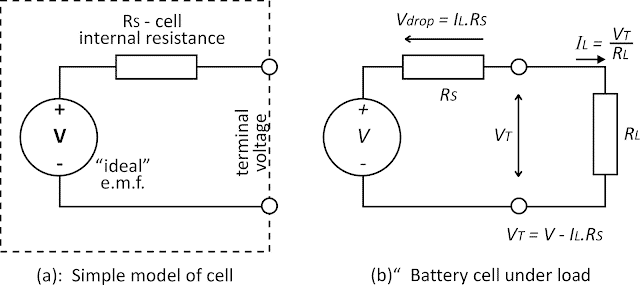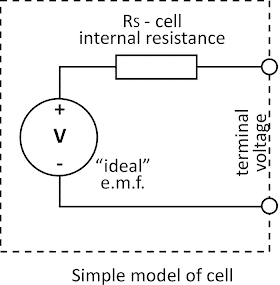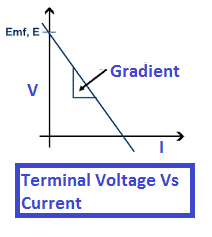The equivalent circuit of the battery is given below. A voltage source can be represented as an EMF source with internal series resistance.

Under no load condition, the current flowing through the battery or cell is zero, and the terminal voltage is exactly equal to the EMF of the cell or battery.
When the cell or battery is connected to the load, the battery supplies current to the load. Now, if we measure the voltage across the load ( that is the same point at battery terminals), the measured voltage will be somewhat less than the battery EMF. The measured voltage at the terminal of the battery when the battery supplies current to load is called the terminal voltage.
What is the reason for the reduction in the battery voltage? There must be some voltage drop inside the battery. Yes, the voltage drop takes place inside the cell because of the internal resistance of the battery. The internal resistance of the voltage source is zero for an ideal voltage source. However, the voltage source can never be an ideal source and its internal resistance can not be zero. The internal resistance of the battery or cell can be made as minimum as possible by selecting the proper metallurgy for the battery materials.
The voltage source has some internal resistance which causes the voltage to drop during discharging of the battery, and the terminal voltage will be less than the EMF of the battery at the time of discharge. Does the terminal voltage is same for all types of loads? No, it depends upon the value of the load. The higher the value of the load, the more will be current from the battery and consequently, the terminal voltage will be less. Let us understand this phenomenon with Kirchhoff’s voltage law.

In the above circuit, the load is infinitive and the current flowing through the battery is zero. The voltage drop across the internal resistance is ILRs is equal to zero because IL is zero, and in this condition, the battery is said to be open-circuited. In open-circuited conditions, the battery terminal voltage is equal to the EMF of the battery.

The cell voltage having EMF V is connected to the load RL. The cell supplies current IL to the load. According to Kirchhoff’s voltage law sum of the potential drops in a closed-loop electric circuit is zero.
V = ILRs + ILRL
V = ILRs + (VT/RL) RL
V = ILRs + VT
If the battery is open circuit, IL=0
V =ILRs + ILRL
V=0 x Rs + (VT/RL) RL
V=0 + VT
VT =V
When the battery is not connected to the load the load current is zero and the battery EMF is equal to the terminal voltage.
Now if the load is connected to the battery, the battery starts supplying the current to the load.
V = ILRs + ILRL
V = ILRs + (VT/RL) RL
V = ILRs + VT
VT = V- ILRs
From the above, it is clear that the terminal VT voltage is less than the EMF of the battery. The reason for less terminal voltage when the battery is under load is voltage drop inside the battery caused by battery internal resistance Rs.
The terminal voltage further depends on the magnitude of the load. The load current depends on the value of the load resistance. The lower value of load resistance causes to draw more current from the battery, and consequently, more voltage drop takes place inside the battery, and there will be less terminal voltage. Let us understand this with an illustrative example.

Case 1: When a battery is under no load
When there is no current flowing through the battery, the terminal voltage is equal to the battery EMF. The battery EMF is 9 volts and the terminal voltage is equal to the battery EMF which is 9 volts.
Case 2: When a battery is under load – Load is 9 Ω
When the battery of 9 volts EMF is connected to 9 Ω resistance the battery will supply 1.49 amp. current to the circuit and the terminal voltage is 8.94 volts. The voltage drop across the internal resistance of the battery is 0.015 volts.
Case 3: When a battery is under load – Load is 6 Ω
When the battery of 9 volts EMF is connected to 6 Ω resistance the battery will supply 0.99 amp. current to the circuit and the terminal voltage is 8.91 volts. The voltage drop across the internal resistance of the battery is 0.001 volts.
From above, it is clear that voltage drop across the internal resistance increases with an increase in the current.
When there is no current flowing through the battery, the terminal voltage is equal to the battery EMF. The battery EMF is 9 volts and the terminal voltage is equal to the battery EMF which is 9 volts.
The terminal voltage decrease with an increase in load current or the current through the battery. The graph showing relationship between voltage and current is shown below.

Illustrative Example:
A battery has 9 volts emf and internal resistance of 0.1 Ohms. Calculate
a) Calculate battery terminal voltage when it is connected to 15 Ohms load.
b) The terminal voltage when it is connected to a 1.0 Ohms load.

b) When the battery is connected to 1.0 Ohms load
